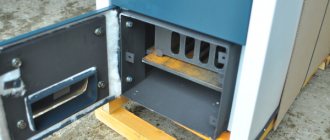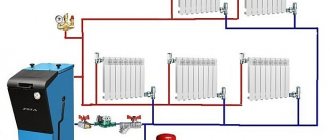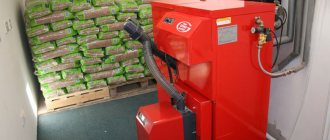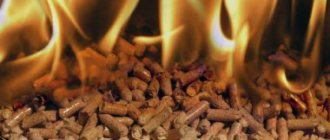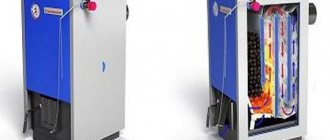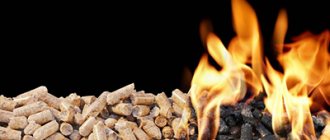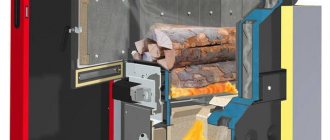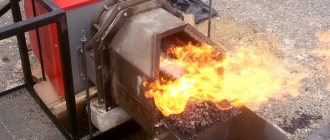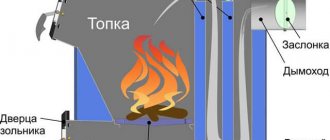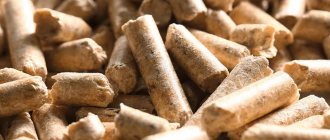Installation of pellet boilers
Heating systems using pellets as fuel have appeared on the mass market relatively recently. The main advantages of compressed fuel pellets, when compared with wood, are relatively high density and low humidity. As a result, the amount of thermal energy released during the combustion of pellets is higher than that of firewood (4100 and 3400 kcal/kg, respectively), and only 50% lower than that of coal (about 6400 kcal/kg). If we compare these indicators with the cost of the listed types of solid fuel, pellet boilers will turn out to be the most profitable.
Components of a pellet boiler:
- fuel loading bunker;
- burner, which is ignited when pellets arrive;
- an auger that supplies pellets from the hopper to the combustion chamber;
- automation equipment for fuel supply and burner ignition.
Pellets are fed into the combustion chamber in portions. During the process of fuel utilization, a built-in fan is turned on, providing forced draft, and thermal energy is transferred through a heat exchanger to the coolant. As soon as the first portion of fuel begins to burn out, the temperature inside the chamber drops, which is recorded by sensors and a signal is given to load the next portion of pellets. The ash formed during the combustion of pellets falls through the grate into a special container.
Functional features of pellets:
- after combustion of a fuel pellet, significantly less waste is generated in the form of ash: a maximum of about 3% of the initial mass of fuel;
- in a dry room, granules can be stored for as long as desired without losing their properties;
- pellets will release a sufficient amount of thermal energy during combustion only in the case of forced air supply;
- For household use, pellets made from pine sawdust or a mixture of waste coniferous wood and bark are best suited.
The practice of using pellet boilers, according to reviews from owners of equipment operating on pellets, indicates that it is characterized by a high efficiency, and semi-automated fuel supply and controlled combustion of pellets significantly facilitate the operation of this equipment.
popular models:
Automatic pellet boiler kiturami korea
South Korea has long been known for its engineering gadgets. The Kiturami concern, quite well known in Russia as a manufacturer of high-quality pellet boilers, was no exception. Despite the fact that in the domestic market, the models are presented in only two modifications: KRP-20A with 24 kW and KRP-50A with 58 kW, the Kiturami automatic pellet boiler is very popular among domestic consumers.
The Kiturami KRP-20A pellet boiler is a two-circuit modification designed to heat a residential building up to 240 m2. The second circuit is used to prepare warm water. Kiturami KRP-20A is equipped with a loading chamber of 150 kg, the volume should provide autonomous heating for four days during the winter period. The Kiturami pellet boiler is equipped with a torch burner and a ceramic heating element.
An attractive feature is the automatic removal of caked slag deposits and ash from the burner tray. The removal procedure is carried out using a mechanical drive during operation. The low cost becomes the main advantage in favor of Kiturami, its price is one and a half times lower than imported models.
Automatic pellet boiler pelletron pelletron 22 kW
In combination with the usual advantages related to the use of automatic pellet boilers, such as: an automation system, prolonged autonomous operation and high efficiency, there are a number of additional advantages for the domestic development of Pelletron KT:
- Convenient loading of granules. Standard designs of pellet boilers, the installation of the loading hopper is located at the top. Indeed, the overall dimensions can be reduced, but the laying process becomes more complex. The Pelletron pellet boiler placed its loading tank at just one meter relative to the ground, thus facilitating the filling of pellets:
- Easy operation Routine maintenance and cleaning of the Pelletron pellet boiler is easy. Access is provided by simple access to all structural elements. All cleaning processes take about 30 minutes per week:
- Low cost A traditional pellet boiler is always expensive equipment. The engineers of the Pelletron design managed to produce the optimal apparatus; you can purchase a boiler at half the cost of its European counterparts.
- Operation without the use of a chimney is possible. The domestic pellet boiler “Pelletron” was designed for operation with forced draft. Equipped with a fan, the boiler does not require a traditional, bulky chimney, and the smoke exhaust fan draws the exhaust gases into a pipe facing the street. The chimney pipe is led directly outside the wall of the room.
The disadvantages of the Pelletron pellet boiler include dependence on electrical power and lack of versatility. The Pelletron boiler does not allow the use of other solid fuels and operates exclusively on pellets. On the other hand, the disadvantage is compensated by heating elements built into the boiler. Heating elements allow you to heat the room from the electrical network, when there are no pellet granules.
In addition, we note the domestic pellet boiler Cooper about 22 kW Teplodar Cooper, which has positive reviews from the owners and offers a very attractive price.
What characteristics should you pay attention to when purchasing?
Having information about the basic principles of operation of pellet boilers, it is much easier to understand the more complex nuances associated with the choice of equipment. This can be achieved by focusing on owner reviews. The key parameter in this case is the boiler power. Its level must be sufficient to heat a building of a given area and serve all users of hot water.
An approximate calculation of power can be performed by multiplying the living area in square meters by 100 W (the maximum level of heat loss at sub-zero temperatures). The obtained result is relevant only for buildings insulated in accordance with all current standards.
We recommend choosing a model whose maximum performance will be 20-30% higher than the calculated values in order to ensure a more gentle operating mode. The Kupper series of boilers includes devices designed for heating buildings with a total area of 90-200 m2.
What other parameters should be considered?
- Auger type
. Teplodar boilers are supplied with a rigid or flexible auger. The first option is more affordable, but limited in functionality. It can be installed in one position, and the distance over which fuel is supplied should not exceed 2 meters. The use of a flexible modification of the auger allows you to create a complex system for transporting pellets and use bunkers of various sizes. - Customizable features
. Automatic settings allow you to reduce human participation in boiler control to a minimum. In the controllers built into Kupper boilers, the user has access to the functions of changing the fuel supply speed, adjusting ignition parameters, and controlling the fan rotation speed. The number of options in automatic boiler control panels opens up the possibility of fine-tuning the equipment (fuel consumption, maintained temperature, room heating rate). - Bunker volume
. Depending on the quality of the pellets and the boiler operating mode settings, fuel consumption may differ from the calculated values. To prevent the pellets from running out too quickly and the bunker not to have to be refilled too often, it is better to choose a storage facility whose volume exceeds the estimated fuel consumption by 10-15%. - Service maintenance
. Today, the buyer has a choice of equipment from many manufacturers of heating systems, both domestic and foreign. However, you must be aware that for this class of equipment, timely service is critically important. has created its own network of authorized service centers. For a long period of time, we have been analyzing the opinions of customers who bought pellet boilers from us: reviews of their work in most regions of the country are extremely positive.
About the advantages and disadvantages of this option
Each heating system option has its pros and cons. Pellet boilers are no exception, and in order to make the right choice, it is necessary to objectively evaluate the capabilities of this equipment. We have already mentioned the favorable ratio of the cost of pellets and the heat transfer resulting from their combustion. Let's list what other advantages they have:
- The optimal heating option if main gas is not supplied to the house, and the power of the electric line is not enough to connect electric heaters.
- Possibility to set up automatic supply of pellets to the burner. The user can adjust the feed speed, and therefore fuel consumption. Automation tools distinguish pellet boilers from other types of solid fuel heating systems.
- Pellets are easy to transport and store. Suppliers pack fuel in compact bags (on average, about 30 kg), which are much easier to store compared to coal or firewood. The only requirement is that in the room in which they will be stored, the air must be moderately humid.
- Pressed pellets consist exclusively of natural wood fibers and do not contain glue or other chemical additives. The ash formed as a result of combustion is environmentally friendly and can be used as fertilizer.
- A standard pellet boiler provides space heating and supplies hot water in the required volume.
- Wide range of options for setting up basic equipment parameters. The user can set a comfortable temperature level, the rest will be taken care of by the boiler automation. Some models may have a function for connecting to a “smart home” system, which will allow you to control the boiler remotely.
- To install a pellet boiler, registration or special permission from regulatory authorities is not required. When installed correctly, it is safe to use and can serve both residential buildings and utility rooms.
There were also some drawbacks. Although in the full sense it is not entirely correct to call the following points disadvantages:
- The cost of equipment is higher than solid-state boilers of other types. However, the equipment will pay for itself fairly quickly.
- To operate a pellet boiler, a constant connection to a power source is required. The problem can be solved by purchasing an autonomous generator or installing a block-modular boiler room.
- Insufficiently developed industry for the production of fuel pellets. In some regions it will take a long time to find a reliable supplier. However, the quality of pellets may be inconsistent.
- Difficulties with self-installation of a pellet boiler. All installation and commissioning work must be carried out by a professional team.
Some pros and cons
- Combustion is supported by pellets, a fairly inexpensive type of fuel.
- They have a high level of efficiency, which brings their characteristics closer to gas boilers.
- Fuel is supplied to the burner and the temperature is maintained automatically.
- Storing pellets is not difficult, since they are packaged in bags (often thirty kilograms each) and only need a dry room.
- When burned, they leave behind small amounts of environmentally friendly ash.
- The pellet appliance provides the house with both hot water and a comfortable, constant temperature regime.
- They have a smart control system; some system models are designed for remote control.
- Pellet equipment for autonomous home heating is safe and does not require registration with regulatory authorities.
When deciding to buy a good pellet boiler, it is worth paying attention to some disadvantages
- Installation and connection to the home heating system must be carried out by qualified specialists.
- Pellet production is not yet well organized, which may result in fuel shortages.
Pallet boiler
What do the owner reviews say?
The most objective information can be gleaned from user reviews: pellet boilers are becoming more and more popular and are more often used in the heating system of a house on one or several floors; the device can also be installed in a bathhouse or serve other outbuildings. We have selected several reviews that characterize the functionality of the equipment and the practical benefits of using pellet boilers.
- The decision to purchase a solid fuel boiler was made immediately after receiving an electricity bill with a five-digit amount. The option with a wood-burning boiler was rejected immediately, since in our region the cost of firewood is too high. We chose the Kupper OVK 10 model; it is optimally suited for a house with an area of less than 100 square meters. m. In total, the savings were twofold compared to electric heating. If you purchase pellets in bulk, you can also get a discount. We are very pleased with the operation of the boiler, it does not require much attention: once every two days we added a fresh portion, cleaned it of ash and you can forget about its existence.
- We installed a pellet heater over a year ago. Pellets are consumed very economically and burn to ash without waste. It works quietly, compact, does not smoke. Almost all friends and acquaintances who were shown the boiler want to install something similar. The Kupper brand has several models of varying power, the main thing is to calculate how much energy is required to heat a particular house and you can choose the appropriate option.
- Heating with pellets is environmentally friendly and the most cost-effective. For a country house or dacha, you can’t think of anything better. The Teplodar company was recommended by friends who had installed such a boiler before. We bought the Cooper OVK 18 model and a month ago it was delivered to us and connected. The menu is clear, you just need to configure it once and that’s it. We change pellets every two to three days.
- We bought a frame house in the country as a summer house. The issue of heating immediately arose, since gas was not supplied to the village. The former owner heated with wood, but we decided to install a pellet boiler on the advice of our neighbors. In total, it turns out that the consumption of pellets in moderate frosts is about 3.5 kilograms per month per square meter of heated area. We order high-quality, premium pellets with minimal ash content. Today, there are practically no alternatives to pellet heating.
Advantages of pellet boilers
Pellet boilers have undoubted advantages:
- Pellets are by far the safest fuel when compared to gas and electricity. But no one mentions such a positive aspect, and, most likely, because no one had any problems in this regard.
- Significantly reduce heating costs compared to electric ones. They have been actively used in Russian realities for several years now, and the reviews of their owners can be trusted. These are not theoretical calculations from foreign sources, but a statement of fact. Some say the costs are reduced by half, others by thirty percent (if you use a two-tariff meter) compared to electric heating devices. With regard to gas, the situation is the opposite. But gas is not available everywhere, and even gas cylinders are not always available. And gas is an explosive substance, unlike pellets.
- High efficiency up to 95% . Manufacturers talk about 97% in some models.
- Availability of an additional hot water supply circuit.
- Pellets are convenient to transport and store, they do not cause allergic reactions, are environmentally friendly and non-toxic. The only requirement for the room for storing them is dryness.
- Pellets are becoming more affordable every year. Today there are already many enterprises producing wood pellets. If several years ago consumer reviews spoke of a shortage of such fuel and the need to stock up on it from the summer for the entire heating season, now the excitement has subsided, and no one sees the need to store ten tons of fuel at once.
- The price of pellets is more stable than electricity or gas tariffs, and now that more and more of them are being produced, its seasonal fluctuations are not so noticeable.
- Heating a country house using a pellet boiler does not require approval for connection and operation; if desired, the equipment can be installed independently.
- Ash after combustion of pellets consists of natural minerals, and there are no problems with its disposal, as their owners have repeatedly noted on forums.
